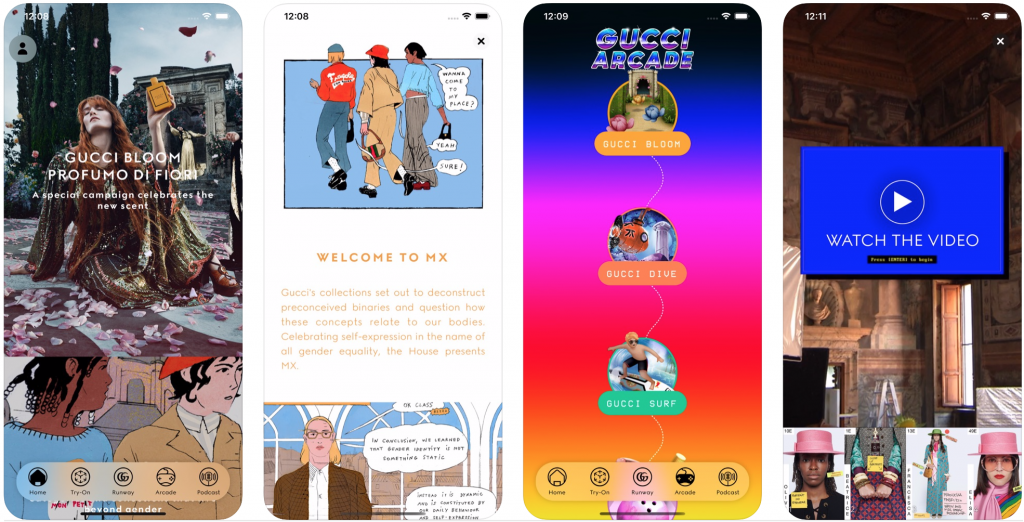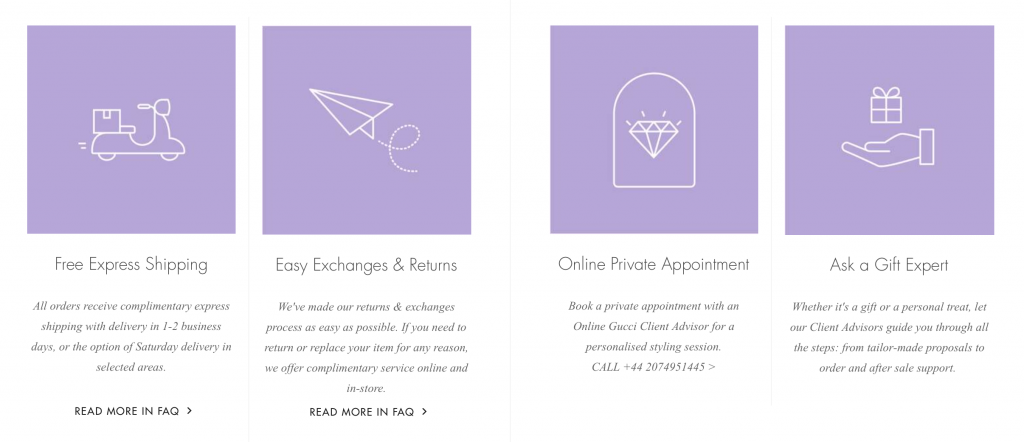Luxury Website Design: How to Create a Luxury Retail Website in 2020
In the luxury retail industry, competition is fierce, standards are incredibly high and trends develop quickly. To compete with internationally renowned brands and entice discerning clientele, you need a website worth shouting about. Our top 2020 luxury website design trends are the essential features you need to create a top-performing, bespoke digital platform.
This guide is the result of weeks of in-depth research scouring the sites, mobile apps and digital features of some of the biggest names in luxury retail in 2020:
Over 60% of the brands we assessed had a luxury retail app.
Every site we reviewed used animated custom cursor effects on their images.
Half of the homepages linked to long-form stories on new product lines.
What Makes a Modern Luxury Website?
A luxury retail website is like a carefully balanced cocktail. To hit the mark with high-end customers, your website must combine cutting-edge technology, tasteful branding, and personalised services, all served up within a fast, smooth interface. A strong working relationship with your web design agency is a must as you collaborate on bringing together your brand identity and digital functionality.
Balance Cutting Edge Technology and Brand Heritage
Incorporating emerging technology into your digital platforms demonstrates bold vision and a healthy budget, the hallmarks of a luxury brand. New tech such as augmented reality is also one of the best ways to engage a younger audience. Gucci’s App includes a ‘Try On’ area where users can virtually try on footwear, make-up and eyewear using AR technology. The futuristic feature positions Gucci at the forefront of experimental technology and elevates the online shopping experience.

However, it’s easy to get immersed in new technology at the expense of brand identity. While the advanced technology Gucci’s website and app can’t be faulted, it lacked information on brand history. Luxury and tradition often go hand in hand, so any innovations need to be balanced against the weight of history. Avoid centring your website on emerging technologies by combining innovation with brand heritage.
Examples of brands which balance emerging technology with brand heritage include:
- Burberry’s ‘Discover the Trench Coat’ section includes seamlessly embedded video snippets along with rotating photos and image carousels, to bring to life the intricate construction of the iconic coat.
- Givenchy details the creation of its iconic handbags with beautiful animations and artistic videos showing each bag coming together from its composite parts. While demonstrated with the use of cutting-edge graphics, the emphasis remains firmly on the quality materials and craftsmanship of the brand.
- Fortnum & Mason did not forego their traditional Christmas brochure for emerging technology but instead fused the two for an updated 21st-century version. It now has a digital counterpart, seamlessly integrated with the website. Links embedded in the brochure file take customers to product pages with a single click.

Unique App Design
Apps can be used to take brands in a bold new direction, deliver personalised products and content, or be the perfect in-store companion. The sheer variety they provide can help luxury brands establish themselves in niche markets with high buying potential.
Examples of brands that offer unique apps alongside their websites:
- Gucci’s App, with its experimental technology and interactive features, has allowed the brand to explore a youthful new direction.
- Harrods has created an in-store shopping companion, complete with Store Index and live route instructions.
- Nike has boldly segmented their audience, creating 4 unique applications that deliver personalised experiences, tailored recommendations and industry-leading content.
There are two crucial takeaways for creating a luxury brand app:
1. Make it easy for your customer to buy with in-app purchases. An app is an excellent platform for your brand messaging and content, but it should also be another point-of-sale.
2. Create apps for both iOS and Android customers. Don’t make the same mistake as Burberry and limit your potential audience. Android accounts for just over half of the UK market and 75% worldwide; iOS devices make up the rest.
Exquisite Photography and Features
Quality photography is the backbone of a luxury retail website. But there’s a lot more to it than simply point and shoot. Photographs of your latest collections can easily change the colour palette of your pages, without requiring a complete site revamp. Equally, being liberal with your use of white space will allow your images to make a striking impact.

Photographs can completely change the visual direction of your site, which is ideal for an industry driven by changing trends. Ensure your website leaves room for creative photography by keeping your side-bars, headings and navigation monochromatic.
Brands currently making the best uses of editorial images include:
- Gucci’s site, which is full of editorial images of whimsical scenes and earthy tones depicting their latest collection. Come back in six months and the site could look completely different.
- Fortnum and Mason’s simple black, white and teal pages are currently packed full of Christmas hampers and Halloween feasts.
Images alone won’t sell your products. Feature pages that combine impressive photography with powerful messaging and visual effects deliver a more enticing spectacle to the user. Selfridges create in-depth ‘Read and Shop’ feature pages to accompany new collections, product launches or in-store additions. Each page is an engaging mix of editorial photography, videos, quotes and products; the added context creates a buzz that cannot be achieved by images alone. These features are integral if you want to position your brand as an authority in a niche market and improve your SEO.

Static photos are also becoming rarer as users expect visual effects. Mulberry displays five years of runway collections by packing pages with subtly moving editorial shots and zoom features. The effect is a far more dynamic experience for the user. The extra investment required to create a more immersive page is worth it to keep discerning customers engaged.
Personalisation with Software and Services
Personalised service for every individual is a core offering of luxury retail. Delivering this online requires a balance between highly sophisticated software and bespoke services. Discuss options such as Wishlists and ‘You May Like’ carousels with your web design agency. Selfridges’ unique ‘New In for You’ section uses a Tinder-style swipe feature that immediately engages the user in a personalised experience. It presents each user with a stack of product images when they swipe right the product is saved to a wishlist. It’s an easy technique any brand can use to gain valuable customer data and provide more relevant product suggestions.
Luxury websites should also provide personal online services, giving elite shoppers the option to connect to a trained customer service representative. Gucci delivers a ‘Guccified Online Shopping Experience’. One of the features instantly connects customers to an ‘Online Client Advisor’ and another to a ‘Gift Expert’. Here, users can receive tailored advice from a Gucci staff member, a far cry from a soulless chatbot.

Combine In-store and Online Potential
If you have an impressive bricks-and-mortar store, show it off! A shopfront is a huge brand identifier and a key piece of your identity that should be celebrated. There are myriad ways you can present in-store décor and experiences on your website. Not only does it showcase the opulence of your store, but it creates a cohesive brand identity and provides incredible marketing opportunities.
The brand’s bringing in-store luxury directly to the online user with excellent retail integration:
- Gucci’s Online Experience goes further than connecting customers to advisors. In the ‘Digital Showroom Experience’, a Client Advisor leads you around the store on a one-way video call, bringing the Gucci store to any screen.
- Harrods’ website offers virtual appointments, booked with a customer-friendly multi-step form. With dedicated personal shoppers on hand, Harrod’s can provide expert advice to online customers anywhere.
Your website is your brand’s most loyal and effective mouthpiece, use it to publicise your newest in-store additions with online features. When Harrods opened a new beauty branch in Essex, it was the focal feature on their website, with a call to action for website visitors to ‘Step Inside’. The feature page included a video tour around the beauty stations, store information and links to purchase the products.
An exquisite display, both in-person and digitally, is a key component that keeps customers choosing luxury brands. Position yourself amongst them with your own unique feature pages.

A Must for 2021: Mobile Optimisation
Mobile and desktop account for almost the same market share. Optimising your site to fit a smaller screen is essential to keep customers purchasing on the move. While apps are a focus for many brands at the moment, your website’s mobile view shouldn’t be forgotten.
The best and worst examples of mobile optimisation:
- Givenchy delivers an incredibly smooth mobile experience. Their customers wouldn’t notice the difference between shopping on a desktop or mobile.
- Harrods, on the other hand, haven’t quite hit the mark. Their poor mobile configuration and its impact on user experience could be a deterrent to customers.
Remain in your customer’s good graces and give them a mobile site that is easy to navigate and makes purchasing a doddle.
The Details You Can’t Afford To Miss
Smaller details often get overlooked, but they combine to make a huge difference to the overall impact of your site. While they aren’t flashy or expensive, the minutiae of web design receive the most attention from consumers and deserve to be perfect.
- Smooth animations display expert web design that sets luxury websites above the rest. Intuitive content carousels, entry animations and faultless zoom features on product images help make your consumer’s experience immersive. Your web design agency will be able to select and customise the best software and plugins for your site.
- Delivering smart funnelling that preempts customer intent is important to create a smooth customer journey. Think carefully about the route your customers take and design your site’s navigation and browsing filters with this in mind. Givenchy’s advanced filter options and uncluttered navigation stood out among all the sites we critiqued. Selfridges and Harrods go beyond the ordinary and both include images linking to the latest launches in their navigations panels.
- Product descriptions are an extension of your brand voice and deserve as much attention as Stories and blog posts. Fortnum & Mason position themselves as a lifestyle brand with their descriptions. They offer advice on ideal product pairings and serving suggestions. Harrods include an Editor’s note with every item.
Methodology
To come up with these findings, we reviewed the digital platforms of 8 luxury retail brands:
Gucci
Burberry
Nike
Givenchy
Harrods
Mulberry
Selfridges
Fortnum & Mason
First, we explored each site as if we were a regular customer. We clicked through the customer journey, assessing ease of navigation and user experience all the way to the checkout. Then, we explored the unique features each brand had to offer by following links to long-form stories, immersive technology and personalised services.
We systematically ranked site performance across 5 key factors:
- Special Features
- User Experience
- Visual Design
- Mobile Optimisation
- Retail Integration
Partner with a Luxury Web Design Agency
Personalised retail experiences utilising the latest technology, impeccable photography combined with custom animations, apps and long-form features are all essential elements of a luxury website. Collectively, they will deliver an impressive digital experience for high-end customers.
Implementing them all is a challenge that requires a top-quality web design agency. Your web design agency will be able to select and customise the best software and plugins for your site. At KIJO we have years of experience working with renowned brands, developing bespoke websites that project luxury and modernity. Get in touch to begin transforming your website.
Posted on by KIJO